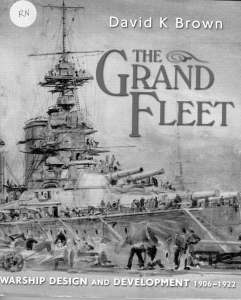- Author
- Book reviewer
- Subjects
- Ship design and development, History - WW1, Book reviews
- Tags
-
- RAN Ships
- None noted.
- Publication
- March 2011 edition of the Naval Historical Review (all rights reserved)
The Grand Fleet – Warship Design 1906-1922
by David K. Brown.
Published by Seaforth Publishing P/L (Pen and Sword Books Ltd), Barnsley (UK), 2010 (originally published by Chatham Publishing in 1999). ISBN: 978 1 84832 085 7.
Price: listed as £16.99 plus p&p.
Availability: Reportedly out of print but a web search reveals that there are plenty of copies available, ranging in price for soft cover from around $A26 to hardcover $A153. 208 pp., b&w, illustrated
Reviewed by LCDR Ron Robb, RAN (Rtd).
 A highly detailed account of the relatively short life of the greatest fleet of modern times. The emphasis is on the rapid technical development that war (in this case World War I) perforce accelerates. Profuse illustrations make identification of ship types and detail easy to follow.
A highly detailed account of the relatively short life of the greatest fleet of modern times. The emphasis is on the rapid technical development that war (in this case World War I) perforce accelerates. Profuse illustrations make identification of ship types and detail easy to follow.
This book is hard to classify. It can be ‘coffee table’, technical reference or naval history. Whatever, the word ‘monumental’ comes to mind. For aficionados of any of those descriptions it is a book in which one can become absorbed for hours or pick it up every so often for a spell of interesting light browsing. As a research tool on the subject it contains a wealth of information. The book is so lavishly illustrated that just browsing through the photos and their accompanying captions is an educational and absorbing experience in itself. Even the footnotes are profuse and will themselves lead a serious researcher further into an endless labyrinth of information. It has to be one of the most, if not the most, detailed reference work on the subject of British warship design over the period of World War I.
The evolution of warships in each class and sub-class is developed in detail and one learns, for example, why secondary armament was repositioned in later developments of a particular class (think gun barrels being constricted in horizontal movement by the position of funnels). Some designs were highly successful as war machines but not up to the mark as ships – for example, Rodney had such powerful guns that they damaged the ship’s structure. Invincible’s Q turret was not able to withstand a direct hit to its top and allowed flash to get inside the ship, down to the magazine and she blew up at Jutland. On the other hand, some designs were so good that they were still serving in World War II. Every class is covered, from the mightiest battleship to the lowest minor vessel. Submarines are included and the fascinating development of the aircraft carrier in such a short space of time is well dealt with. Machinery, both propulsion and secondary, design and development is covered in detail. There is a discussion on ship stability and particular attention is given to the problems of riveting (which construction was used for all Grand Fleet ships).
The argument as to whether the battleship was ever of any real use is still hotly debated to this day and an interesting appendix addresses that issue. Some previously secret papers on the subject are revealed. Jutland is still a good topic for a debate and, while the aircraft carrier patently spelled the death knell of the battleship, it is also true that the mere existence of Tirpitz in a Norwegian fiord was sufficient to tie down a scarce element of the Royal Navy and absorb a lot of effort by the Royal Air Force. For either side of the argument this book provides plenty of material.
Despite its fame and power, the Grand Fleet existed only from 1914 to 1922, though as the book’s sub-title implies its genesis began in 1906; in one fell swoop the building of Dreadnought made all existing capital vessels in all navies redundant (including the Royal Navy itself). The fleet was formed by combining the Atlantic and the Home Fleets. It was based in Scapa Flow and took part in only the one famous – (or infamous, depending on one’s point of view) battle. It had only two commanders: Admiral Sir John Jellicoe and Admiral Sir David Beatty. When it disbanded it returned to mainly being the Atlantic Fleet.
Brown raises some fascinating thoughts about the demise of the Royal Navy being traced back to the end of the Grand Fleet. At the end of World War I the RN ships were worn out and being overtaken by newer designs from the United States and Japan, which were not so strapped for money. Brown quotes Admiral Sir Louis le Bailly (well known to a previous generation of naval engineers) who averred that the post World War I naval hierarchy was inimical to things technical and fell behind in the race to World War II. Moreover, progressive naval officers, especially of the air branch, slipped across to the Royal Air Force and the result of that for the Navy during the 1930s is well known. All these conjectures and observations, and many more, are discussed and if any naval debating teams are looking for some topics to start a war of words then this book has plenty of suggestions.




